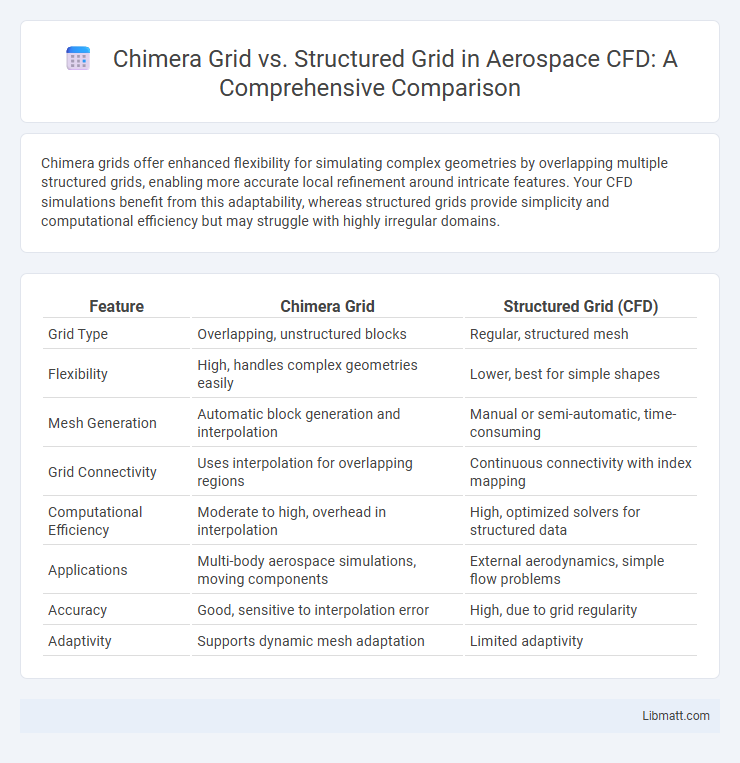Chimera grids offer enhanced flexibility for simulating complex geometries by overlapping multiple structured grids, enabling more accurate local refinement around intricate features. Your CFD simulations benefit from this adaptability, whereas structured grids provide simplicity and computational efficiency but may struggle with highly irregular domains.
Table of Comparison
| Feature | Chimera Grid | Structured Grid (CFD) |
|---|---|---|
| Grid Type | Overlapping, unstructured blocks | Regular, structured mesh |
| Flexibility | High, handles complex geometries easily | Lower, best for simple shapes |
| Mesh Generation | Automatic block generation and interpolation | Manual or semi-automatic, time-consuming |
| Grid Connectivity | Uses interpolation for overlapping regions | Continuous connectivity with index mapping |
| Computational Efficiency | Moderate to high, overhead in interpolation | High, optimized solvers for structured data |
| Applications | Multi-body aerospace simulations, moving components | External aerodynamics, simple flow problems |
| Accuracy | Good, sensitive to interpolation error | High, due to grid regularity |
| Adaptivity | Supports dynamic mesh adaptation | Limited adaptivity |
Introduction to Chimera Grid and Structured Grid in CFD
Chimera Grid and Structured Grid are two distinct approaches used in computational fluid dynamics (CFD) for mesh generation and simulation accuracy. Structured Grids consist of orderly, grid-like cells aligned in a predictable pattern, ideal for simple geometries but limited in handling complex shapes. Chimera Grid, also known as overset grid, overlaps multiple structured grids, allowing your simulations to accurately capture intricate geometries and moving boundaries with enhanced flexibility and precision.
Fundamental Concepts of Grid Generation
Chimera grids use overlapping, independently generated grids that facilitate complex geometry handling and local mesh refinement, improving solution accuracy in turbulent or multi-body flows. Structured grids consist of a regular, grid-like topology with logically rectangular mesh points, enabling efficient memory storage and straightforward numerical implementation but challenging adaptive refinements. The fundamental difference lies in mesh flexibility; Chimera grids promote geometric modularity and localized resolution, whereas structured grids emphasize simplicity and computational speed through consistent grid connectivity.
Chimera Grid: Definition and Key Features
Chimera Grid, also known as overset grid, consists of multiple overlapping grids that simplify the modeling of complex geometries and moving boundaries in CFD simulations. Key features include independent grid generation, enhanced local refinement, and efficient handling of dynamic interfaces, enabling accurate flow analysis around intricate structures. Your simulations benefit from improved flexibility and accuracy when using Chimera Grids compared to traditional Structured Grids.
Structured Grid: Definition and Key Characteristics
Structured grid in computational fluid dynamics (CFD) refers to a grid system where the computational domain is divided into a regular, organized mesh of hexahedral or quadrilateral cells with a fixed connectivity pattern. It offers advantages such as simplified data storage, efficient numerical algorithms, and straightforward indexing for interpolation and differentiation. Structured grids are particularly effective for simulations involving simple geometries with smooth boundaries, enabling higher accuracy and faster convergence in solving fluid flow equations.
Mesh Flexibility and Geometric Complexity
Chimera grid offers superior mesh flexibility by allowing overlapping grids that adapt easily to complex geometries and moving boundaries, enhancing accuracy in CFD simulations. Structured grids, while computationally efficient and straightforward, struggle with intricate shapes due to their rigid, block-like mesh generation. Your choice impacts how accurately you capture flow features around complex geometries, with Chimera grids providing better adaptability for detailed analysis.
Computational Efficiency and Resource Requirements
Chimera grids offer enhanced computational efficiency by allowing localized mesh refinement around complex geometries, reducing the total number of grid points compared to structured grids that require uniform meshing. This selective refinement decreases memory usage and computational time, optimizing resource allocation for large-scale CFD simulations. Structured grids, while simpler to implement, often demand higher computational resources due to their rigid topology and inability to adapt mesh resolution dynamically.
Accuracy and Numerical Stability Comparison
Chimera grids offer enhanced flexibility in modeling complex geometries, resulting in improved local accuracy compared to structured grids, which are typically limited by their regular topology. Numerical stability in Chimera grids can be challenging due to interpolation errors at grid overlaps, while structured grids benefit from straightforward discretization and stable numerical schemes. Advanced interpolation techniques in Chimera grids help mitigate stability issues, but structured grids maintain superior overall numerical robustness for simpler flow domains.
Applications and Use Cases in Industry
Chimera grids are widely utilized in aerospace and automotive industries for simulating complex geometries and moving components such as rotating blades and multi-body interactions, enabling localized mesh refinement and dynamic grid adaptation. Structured grids excel in applications requiring high accuracy and efficiency in simple, regular geometries like internal flow analysis in turbines and heat exchangers within energy and manufacturing sectors. Both grid types are integral to optimizing fluid dynamics simulations in industrial design, with Chimera grids favored for flexibility and structured grids preferred for computational speed and solution accuracy.
Advantages and Limitations of Each Grid Type
Chimera grids offer enhanced flexibility by allowing overlapping, non-conformal meshes that simplify complex geometries and moving boundary simulations, making them ideal for problems involving multiple interacting bodies. However, they require intricate interpolation schemes at grid interfaces, which can introduce interpolation errors and increase computational overhead. Structured grids provide high computational efficiency and accuracy due to their regular mesh topology and straightforward indexing but struggle with complex geometries and dynamic boundaries, often necessitating significant grid refinement or re-meshing.
Choosing the Right Grid for Your CFD Simulation
Selecting the appropriate grid type for your CFD simulation depends on the complexity of the geometry and required accuracy. Chimera grids offer flexibility by overlapping structured grids, enabling easier mesh generation around complex geometries and moving boundaries, while structured grids provide efficient computation and high accuracy for simpler, well-defined domains. Evaluating grid adaptation, computational cost, and solver compatibility is crucial to optimize simulation performance and results.
Chimera Grid vs Structured Grid (CFD) Infographic

 libmatt.com
libmatt.com